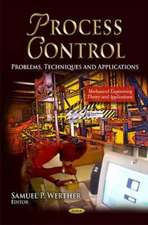Geometric Fundamentals of Robotics: Monographs in Computer Science
Autor J. M. Seligen Limba Engleză Paperback – 25 noi 2010
Geometric Fundamentals of Robotics serves a wide audience of graduate students as well as researchers in a variety of areas, notably mechanical engineering, computer science, and applied mathematics. It is also an invaluable reference text.
| Toate formatele și edițiile | Preț | Express |
|---|---|---|
| Paperback (1) | 505.30 lei 6-8 săpt. | |
| Springer – 25 noi 2010 | 505.30 lei 6-8 săpt. | |
| Hardback (1) | 651.51 lei 6-8 săpt. | |
| Springer – 19 noi 2004 | 651.51 lei 6-8 săpt. |
Din seria Monographs in Computer Science
- 20%
 Preț: 1322.33 lei
Preț: 1322.33 lei - 20%
 Preț: 511.92 lei
Preț: 511.92 lei - 20%
 Preț: 1285.31 lei
Preț: 1285.31 lei - 20%
 Preț: 333.22 lei
Preț: 333.22 lei - 20%
 Preț: 328.60 lei
Preț: 328.60 lei - 15%
 Preț: 646.94 lei
Preț: 646.94 lei - 20%
 Preț: 357.48 lei
Preț: 357.48 lei - 20%
 Preț: 339.47 lei
Preț: 339.47 lei - 20%
 Preț: 653.21 lei
Preț: 653.21 lei - 20%
 Preț: 329.44 lei
Preț: 329.44 lei - 20%
 Preț: 993.74 lei
Preț: 993.74 lei - 20%
 Preț: 992.26 lei
Preț: 992.26 lei - 20%
 Preț: 1630.95 lei
Preț: 1630.95 lei - 20%
 Preț: 656.03 lei
Preț: 656.03 lei - 20%
 Preț: 650.08 lei
Preț: 650.08 lei - 20%
 Preț: 328.09 lei
Preț: 328.09 lei - 20%
 Preț: 641.16 lei
Preț: 641.16 lei - 20%
 Preț: 334.38 lei
Preț: 334.38 lei - 18%
 Preț: 737.74 lei
Preț: 737.74 lei - 20%
 Preț: 642.19 lei
Preț: 642.19 lei - 20%
 Preț: 641.99 lei
Preț: 641.99 lei - 20%
 Preț: 345.59 lei
Preț: 345.59 lei - 20%
 Preț: 711.29 lei
Preț: 711.29 lei - 20%
 Preț: 1001.16 lei
Preț: 1001.16 lei - 20%
 Preț: 661.47 lei
Preț: 661.47 lei - 20%
 Preț: 343.62 lei
Preț: 343.62 lei - 20%
 Preț: 644.81 lei
Preț: 644.81 lei - 20%
 Preț: 640.69 lei
Preț: 640.69 lei -
 Preț: 396.78 lei
Preț: 396.78 lei - 18%
 Preț: 956.81 lei
Preț: 956.81 lei - 20%
 Preț: 592.68 lei
Preț: 592.68 lei - 20%
 Preț: 329.44 lei
Preț: 329.44 lei -
 Preț: 383.33 lei
Preț: 383.33 lei - 20%
 Preț: 349.40 lei
Preț: 349.40 lei - 20%
 Preț: 832.40 lei
Preț: 832.40 lei - 20%
 Preț: 993.42 lei
Preț: 993.42 lei - 15%
 Preț: 578.87 lei
Preț: 578.87 lei - 20%
 Preț: 337.85 lei
Preț: 337.85 lei - 20%
 Preț: 988.16 lei
Preț: 988.16 lei - 20%
 Preț: 996.56 lei
Preț: 996.56 lei - 20%
 Preț: 1293.37 lei
Preț: 1293.37 lei - 20%
 Preț: 1452.94 lei
Preț: 1452.94 lei
Preț: 505.30 lei
Preț vechi: 594.48 lei
-15% Nou
Puncte Express: 758
Preț estimativ în valută:
96.69€ • 103.39$ • 80.62£
96.69€ • 103.39$ • 80.62£
Carte tipărită la comandă
Livrare economică 18 aprilie-02 mai
Preluare comenzi: 021 569.72.76
Specificații
ISBN-13: 9781441919298
ISBN-10: 1441919295
Pagini: 420
Ilustrații: XVIII, 398 p. 32 illus.
Dimensiuni: 155 x 235 x 22 mm
Greutate: 0.59 kg
Ediția:Softcover reprint of hardcover 2nd ed. 2005
Editura: Springer
Colecția Springer
Seria Monographs in Computer Science
Locul publicării:New York, NY, United States
ISBN-10: 1441919295
Pagini: 420
Ilustrații: XVIII, 398 p. 32 illus.
Dimensiuni: 155 x 235 x 22 mm
Greutate: 0.59 kg
Ediția:Softcover reprint of hardcover 2nd ed. 2005
Editura: Springer
Colecția Springer
Seria Monographs in Computer Science
Locul publicării:New York, NY, United States
Public țintă
GraduateCuprins
Lie Groups.- Subgroups.- Lie Algebra.- A Little Kinematics.- Line Geometry.- Representation Theory.- Screw Systems.- Clifford Algebra.- A Little More Kinematics.- The Study Quadric.- Statics.- Dynamics.- Constrained Dynamics.- Differential Geometry.
Recenzii
From the reviews of the second edition:
"The aim of this book is to introduce mathematical tools, especially geometric ones, e.g. Lie groups and allied concepts, for solving problems in robotics. … The author presents in a clear and detailed fashion solutions to problems in robot control and design, especially for robot manipulators. Hence, the compilation would be of interest and help to graduate students and research workers in robotics, mechanical engineering, computer science and applied mathematics … a very sound and comprehensive treatise." (Robotica, Vol. 24, 2006)
"J.M. Selig … has produced this 2nd edition in the series ‘Monograph in Computer Science’. The first publication met the demand for such a book and the second is still a unique contribution to geometric concepts that are all-important to robotics. … It does include much ‘state-of-the-art’ material and the author connects it to the mathematical fundamentals in group theory and geometry. Cyberneticians interested in this area will probably prefer this approach to basics, and it should serve both students and researchers … . " (C.J.H. Mann, Kybernetes, Vol. 34 (7-8), 2005)
"This is the second edition of a book initially published with a slightly different title [Geometrical methods in robotics]. Two new chapters have been added. … it excels in embedding the topic in a historical context, showing how the works of Ball one hundred years ago … can now be expressed very elegantly and efficiently. The author excels also in showing the interplay between robotics and mathematics. In particular, the presence of differential and algebraic geometry is well outlined." (A. Akutowicz, Zentralblatt MATH, Vol. 1062 (13), 2005)
"The book presents a vast collection of algebraic and geometric methods that have found an application in the theory of mechanisms and robotics. … I think that this book constitutes a fundamental contribution to mathematicalrobotics that will stimulate mathematically oriented robotics research, and foster a transformation of robotics into a scientific discipline." (Krzysztof Tehon, Mathematical Reviews, Issue, 2007 i)
"The aim of this book is to introduce mathematical tools, especially geometric ones, e.g. Lie groups and allied concepts, for solving problems in robotics. … The author presents in a clear and detailed fashion solutions to problems in robot control and design, especially for robot manipulators. Hence, the compilation would be of interest and help to graduate students and research workers in robotics, mechanical engineering, computer science and applied mathematics … a very sound and comprehensive treatise." (Robotica, Vol. 24, 2006)
"J.M. Selig … has produced this 2nd edition in the series ‘Monograph in Computer Science’. The first publication met the demand for such a book and the second is still a unique contribution to geometric concepts that are all-important to robotics. … It does include much ‘state-of-the-art’ material and the author connects it to the mathematical fundamentals in group theory and geometry. Cyberneticians interested in this area will probably prefer this approach to basics, and it should serve both students and researchers … . " (C.J.H. Mann, Kybernetes, Vol. 34 (7-8), 2005)
"This is the second edition of a book initially published with a slightly different title [Geometrical methods in robotics]. Two new chapters have been added. … it excels in embedding the topic in a historical context, showing how the works of Ball one hundred years ago … can now be expressed very elegantly and efficiently. The author excels also in showing the interplay between robotics and mathematics. In particular, the presence of differential and algebraic geometry is well outlined." (A. Akutowicz, Zentralblatt MATH, Vol. 1062 (13), 2005)
"The book presents a vast collection of algebraic and geometric methods that have found an application in the theory of mechanisms and robotics. … I think that this book constitutes a fundamental contribution to mathematicalrobotics that will stimulate mathematically oriented robotics research, and foster a transformation of robotics into a scientific discipline." (Krzysztof Tehon, Mathematical Reviews, Issue, 2007 i)
Textul de pe ultima copertă
Geometric Fundamentals of Robotics provides an elegant introduction to the geometric concepts that are important to applications in robotics. This second edition is still unique in providing a deep understanding of the subject: rather than focusing on computational results in kinematics and robotics, it includes significant state-of-the art material that reflects important advances in the field, connecting robotics back to mathematical fundamentals in group theory and geometry.
Key features:
* Begins with a brief survey of basic notions in algebraic and differential geometry, Lie groups and Lie algebras
* Examines how, in a new chapter, Clifford algebra is relevant to robot kinematics and Euclidean geometry in 3D
* Introduces mathematical concepts and methods using examples from robotics
* Solves substantial problems in the design and control of robots via new methods
* Provides solutions to well-known enumerative problems in robot kinematics using intersection theory on the group of rigid body motions
* Extends dynamics, in another new chapter, to robots with end-effector constraints, which lead to equations of motion for parallel manipulators
Geometric Fundamentals of Robotics serves a wide audience of graduate students as well as researchers in a variety of areas, notably mechanical engineering, computer science, and applied mathematics. It is also an invaluable reference text.
-----
From a Review of the First Edition:
"The majority of textbooks dealing with this subject cover various topics in kinematics, dynamics, control, sensing, and planning for robot manipulators. The distinguishing feature of this book is that it introduces mathematical tools, especially geometric ones, for solving problems in robotics. In particular, Lie groups and allied algebraic and geometric concepts are presented in a comprehensive manner to an audience interested in robotics. The aim of the author is to show the power and elegance of these methods as they apply to problems in robotics."
--MathSciNet
Key features:
* Begins with a brief survey of basic notions in algebraic and differential geometry, Lie groups and Lie algebras
* Examines how, in a new chapter, Clifford algebra is relevant to robot kinematics and Euclidean geometry in 3D
* Introduces mathematical concepts and methods using examples from robotics
* Solves substantial problems in the design and control of robots via new methods
* Provides solutions to well-known enumerative problems in robot kinematics using intersection theory on the group of rigid body motions
* Extends dynamics, in another new chapter, to robots with end-effector constraints, which lead to equations of motion for parallel manipulators
Geometric Fundamentals of Robotics serves a wide audience of graduate students as well as researchers in a variety of areas, notably mechanical engineering, computer science, and applied mathematics. It is also an invaluable reference text.
-----
From a Review of the First Edition:
"The majority of textbooks dealing with this subject cover various topics in kinematics, dynamics, control, sensing, and planning for robot manipulators. The distinguishing feature of this book is that it introduces mathematical tools, especially geometric ones, for solving problems in robotics. In particular, Lie groups and allied algebraic and geometric concepts are presented in a comprehensive manner to an audience interested in robotics. The aim of the author is to show the power and elegance of these methods as they apply to problems in robotics."
--MathSciNet
Caracteristici
Provides an elegant introduction to the geometric concepts that are important to applications in robotics Includes significant state-of-the art material that reflects important advances, connecting robotics back to mathematical fundamentals in group theory and geometry An invaluable reference that serves a wide audience of grad students and researchers in mechanical engineering, computer science, and applied mathematics

















